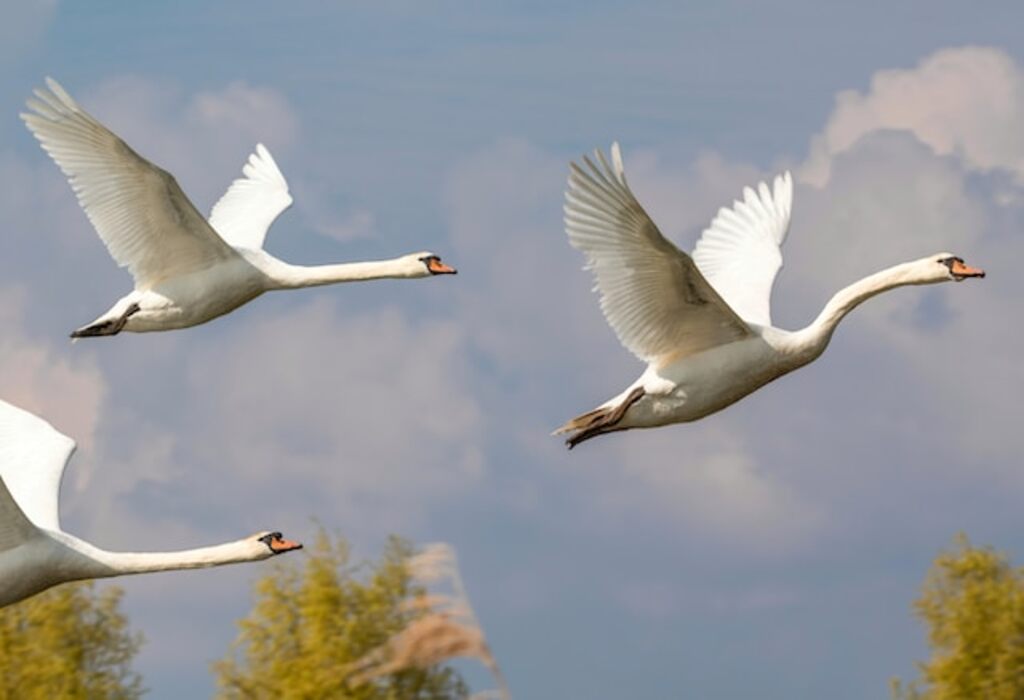“Can Swans Fly?” is a question that might make you scratch your head. After all, swans are known for their grace and beauty on the water, but can they take to the skies? The short answer is yes, but there’s more to it than that.
In this article, we’ll explore the surprising abilities of swans and how they’re able to soar through the air despite their hefty size. Get ready to spread your wings and take flight into the world of swan flight!
Table of Contents
Swans and Flight
How Swans Fly
Swans are known for their graceful movements on the water, but they are also impressive flyers. They have the ability to fly at high speeds over long distances. Swans use their powerful wings to lift their heavy bodies off the ground and into the air.
They are able to fly by flapping their wings in a rhythmic motion, which generates lift and thrust. Swans are also able to glide through the air, using the wind to stay aloft.
Bodies Designed for Flight
Swans have a unique anatomy that is designed for flight. Their wings are long and powerful, allowing them to generate the lift and thrust necessary for flight.
They also have a large breastbone, which provides the necessary support for their powerful wing muscles. Swans have a streamlined body shape, which reduces air resistance and allows them to fly more efficiently.
Statistics
Different species of swans have different flying abilities. Tundra swans, for example, can fly at speeds of up to 60 miles per hour and reach heights of up to 8,000 feet. Swans typically fly at altitudes ranging from 2,000 to 4,000 feet above ground level.
The distance they cover during migration can span several thousand kilometers, depending on their specific migration patterns.
Here are some key statistics related to swans and flight:
| Species | Wingspan | Flying Speed | Flying Altitude |
|---|---|---|---|
| Tundra Swan | 5-6 feet | 50-60 mph | 6,000-8,000 feet |
| Trumpeter Swan | 7-8 feet | 40-50 mph | 6,000-8,000 feet |
| Mute Swan | 6-7 feet | 30-40 mph | 2,000-4,000 feet |
In conclusion, swans are impressive flyers with unique anatomy and flying abilities. They are capable of flying long distances at high speeds and altitudes.
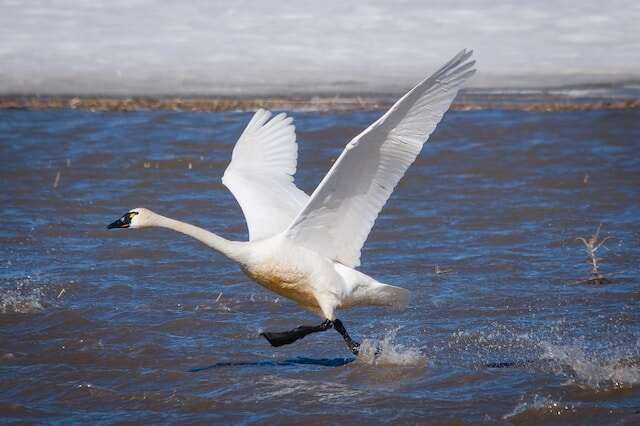
Non-Migratory Flight
Swans are known for their majestic appearance and graceful movements, both on land and in the air. While some swan species are migratory, others are non-migratory and instead, are nomadic. In this section, we will explore non-migratory flight in swans.
Do Swans Fly?
Yes, swans can fly. In fact, they can fly at remarkable speeds of up to 60 miles per hour, indicating their significant flying capabilities. However, not all swans are migratory.
Non-migratory swans, like the black swan and mute swan, are known to fly short distances to find better feeding grounds or more favorable weather conditions.
Cygnets
Baby swans, also known as cygnets, are not able to fly until they are four to seven months old. During this time, they are dependent on their parents for food and protection. Once they are able to fly, they will join their parents in their non-migratory flight patterns.
When and Why Swans Fly
Swans that do not migrate usually fly during the daytime and rest at night. They are known to fly short distances to find better feeding grounds or escape unfavorable weather conditions.
For example, if a particular area becomes too crowded or the food supply runs low, non-migratory swans will fly to a new location in search of better conditions.
In conclusion, while not all swans are migratory, non-migratory swans are known to fly short distances to find better feeding grounds or more favorable weather conditions.
Baby swans are not able to fly until they are four to seven months old and are dependent on their parents for food and protection.
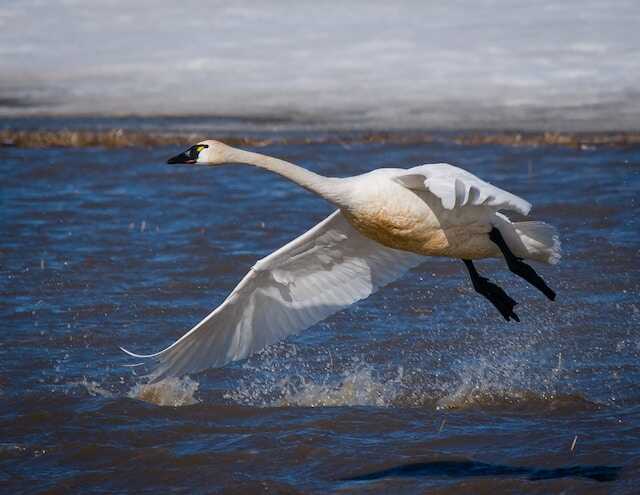
Migratory Flight
Do Swans Migrate?
Yes, all types of swans are migratory birds. They cannot survive in cold and harsh weather, so they migrate from cold climates to warmer ones. As winter approaches and bodies of water such as lakes, streams, and rivers begin to freeze over, numerous swans embark on group or paired migrations.
How Far Do Swans Migrate?
Swans can fly long distances during migration, up to several hundred miles a day. Tundra swans are capable of flying at speeds ranging from 18 to 30 miles per hour and reaching altitudes of 6 to 8 thousand feet.
In some cases, flocks of these birds have been observed flying up to 50 to 60 mph with the assistance of a tailwind.
As for trumpeter swans, they migrate in stages, taking breaks along their journey. Stopover sites are frequently selected in locations that have large bodies of open water.
Do Swans Fly In Formation?
Yes, swans fly in a diagonal line or V formation when they migrate in groups. This formation helps them conserve energy by reducing air resistance and making it easier to communicate with each other.
The lead bird in the V formation creates an upwash of air that lifts the bird behind it, resulting in a more efficient flight. Swans also rotate positions within the formation to share the workload of leading and resting.
Swan migration is an important part of their ecology and conservation efforts. Understanding their migration patterns and behaviors can help in their protection and preservation.
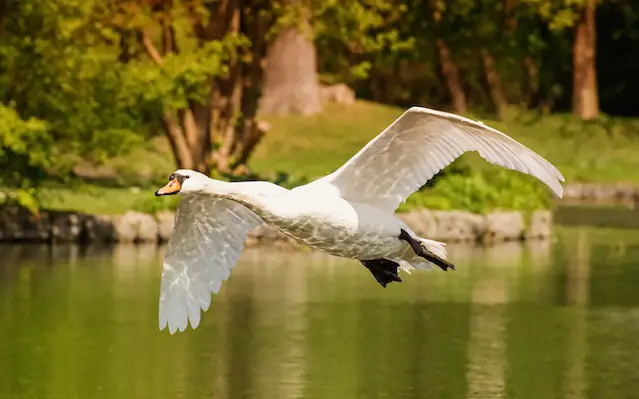
Types of Swans and Flying Capabilities
Swans are a part of the waterfowl family Anatidae, along with ducks and geese. They are known for their ability to swim, fly, and float on water. There are several species of swans, each with unique characteristics and flying abilities.
How Far Can Mute Swans Fly?
Mute swans are the most common swan species in North America and Europe. Their wingspan can reach up to 8 feet and their weight can reach as much as 30 pounds.
Mute swans are capable of flying up to 50 miles per hour and can fly for long distances, up to 60 miles in a day. They are known to migrate to warmer areas during the winter months.
How Far Can Whooper Swans Fly?
Whooper swans are found in northern Europe and Asia. They have a wingspan of up to 9 feet and can weigh up to 30 pounds. Whooper swans are strong fliers and can fly for long distances, up to 700 miles in a single day. They are known to migrate to warmer areas during the winter months.
How Far Can Black Swans Fly?
Black swans are originally from Australia and New Zealand. They have a wingspan of up to 6 feet and can weigh up to 17 pounds. Black swans are capable of flying for long distances and can reach heights of up to 6,500 feet. They are known to migrate to different areas in search of food and water.
Swans have a unique flying style, with slow, powerful wingbeats that allow them to fly for long periods without tiring. They are also capable of flying at high altitudes, making them well-suited for long-distance migration.
In terms of conservation, swans are considered a vulnerable species due to habitat loss and hunting. Many swan species are protected by law, and efforts are being made to conserve their populations.
In conclusion, swans are impressive fliers with unique flying abilities. Different species of swans have different flying capabilities, with some capable of flying long distances and reaching high altitudes. Conservation efforts are important to ensure the survival of these majestic birds.
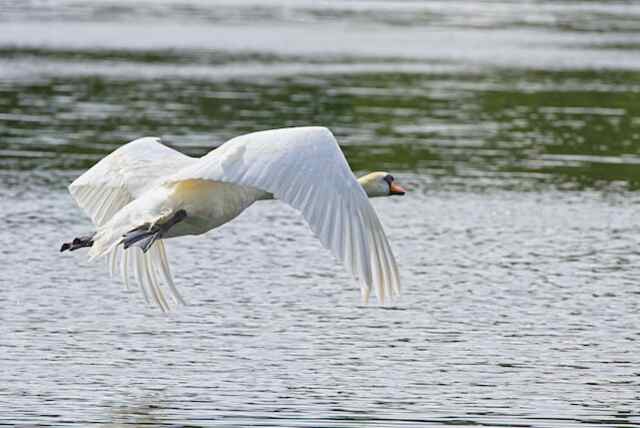
Swans and Cygnets
Swans are known for their graceful swimming and elegant appearance, but they are also impressive flyers. All types of swans are able to fly and can soar to altitudes ranging from 6,000 to 8,000 feet, while typically flying at speeds averaging between 20 and 30 miles per hour. But at what age can swans fly, and do they fly with their cygnets?
What Age Can Swans Fly At?
Cygnets, or baby swans, typically begin to fly around 12 weeks old or before 3 to 4 months after hatching. At this point, their chest muscles and flight feathers are strong enough for them to take short practice flights with their parents. As they continue to grow and develop, they will become more skilled at flying and able to travel longer distances.
Do Swans Fly With Cygnets?
While swans are capable of flight, they do not typically fly with their cygnets. Instead, the parents will lead their young on swimming expeditions to teach them how to navigate and find food.
As the cygnets grow and become more independent, they will begin to venture further away from their parents and eventually leave to start their own families.
Swan parenting is a fascinating process to observe. Both the male and female swans take an active role in caring for their young, with the male often defending the nest and territory while the female incubates the eggs.
Once the cygnets hatch, both parents will work together to feed and protect their offspring.
In conclusion, while swans are impressive flyers, they do not typically fly with their cygnets. Cygnets begin to fly at around 12 weeks old, and swan parenting is a collaborative effort between both parents to ensure the survival and success of their young.
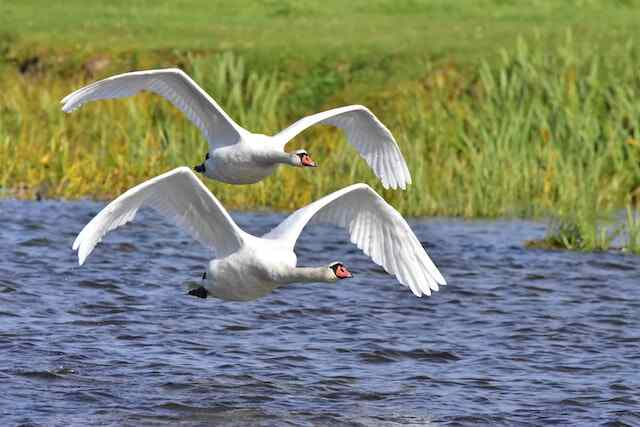
Swans’ Flying Capabilities
Swans are graceful birds that are known for their beauty and elegance. But, can they fly? The answer is yes! Swans are capable of flying, and they are actually one of the largest and heaviest flying birds. In this section, we will explore the flying capabilities of swans.
How Far Can Swans Fly?
Swans are migratory birds, and they can travel thousands of kilometers each year. The distance they cover depends on their species and their migration habits. Some swans can fly up to 3,000 miles during their migration.
How High Can Swans Fly?
Swans can fly at impressive heights, with some species reaching altitudes of up to 20,000 feet. However, most swans typically fly at altitudes ranging from 2,000 to 4,000 feet above the ground. The height at which they fly also depends on their species and their migration patterns.
How Fast Can Swans Fly?
Swans are not the fastest birds in the sky, but they are still capable of flying at impressive speeds. They have an average flying speed of 20-30 miles per hour. However, during their migration, some species can reach speeds of up to 50 miles per hour.
Swans have a unique physiology that allows them to fly. They have powerful wings that are capable of generating enough lift to keep their heavy bodies in the air. Their wingspan can range from 6 to 10 feet, depending on the species.
Swans are also known for their elegant behavior in flight. They often fly in a V-formation, which helps to conserve energy by reducing wind resistance. This behavior is also seen in other migratory birds.
In terms of lifespan, swans can live up to 20 years in the wild. Their diet consists of plants, insects, and small aquatic animals. They have a unique anatomy that allows them to feed on the bottom of lakes and rivers.
In conclusion, swans are capable of flying, and they have impressive flying capabilities. They can travel long distances, fly at high altitudes, and reach impressive speeds. Their physiology, behavior, and anatomy all contribute to their ability to fly.

FAQs: Can Swans Fly?
Can swans fly yes or no?
Yes, swans are capable of flying, though they are usually seen swimming on water. They are strong fliers and can fly up to 50 miles per hour.
Can a swan fly from the ground?
Yes, swans can take off and fly from the ground. They require a running start to take off, which helps them to generate enough lift to become airborne.
When can swans fly?
Swans can fly all year round, but they are most active during their breeding season, which is usually from March to June.
Can British swans fly?
Yes, British swans can fly, just like any other swans. However, they tend to fly less frequently and for shorter distances than migratory swans.
What is unusual about swans?
One unusual feature of swans is that they form strong, monogamous pair bonds that can last for life. They are also known for their graceful appearance and distinctive honking calls.
Which bird cannot fly?
The ostrich is the largest bird that cannot fly. Although it has wings, it is too heavy to become airborne and instead uses its wings for balance and courtship displays.
What is the closest animal to a swan?
The closest animal to a swan is probably another member of the waterfowl family, such as a duck or a goose. Swans are also related to other large birds, such as cranes and storks.
Why do swans honk when flying?
Swans honk when flying as a means of communication with other birds in their flock. They may use honking to signal their location, to coordinate their flight patterns, or to alert others to potential dangers.
What to do if a swan chases you?
If a swan chases you, it is best to avoid running or screaming, as this may agitate the bird further. Instead, try to back away slowly and calmly, keeping a safe distance from the bird. If necessary, seek help from a wildlife expert or animal control.
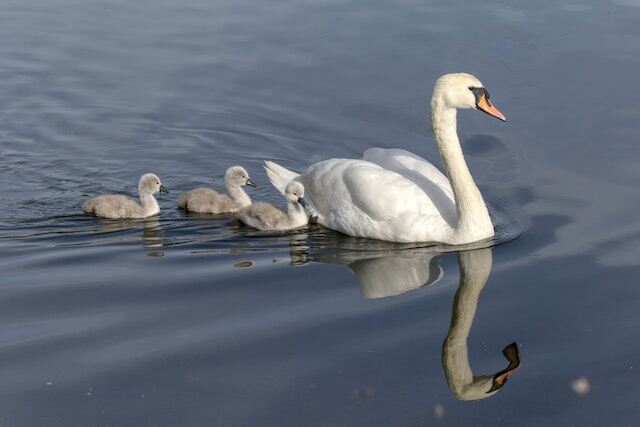
Conclusion
Swans are majestic birds that have captured the imagination of humans for centuries. From their symbolism in art and mythology to their graceful movements in Swan Lake, swans have been a source of inspiration for many.
One of the most fascinating aspects of swans is their ability to fly. Swans are capable of flying at varying heights, speeds, and distances, depending on the species and their wingspan.
While not all swans need to migrate, those that do can fly thousands of kilometers a year. Some species, like the Tundra Swan, can fly several hundred miles each day, averaging a speed of 18 to 30 miles per hour and flying at 6,000 to 8,000 feet.
Swans’ large wings and bodies allow them to fly higher and faster in the sky. They can fly in search of food, better habitat, and in the company of their mates.
Swans have an average flying speed of 20-30 miles per hour and can reach heights of 2,000 to 8,000 feet over land. The science of swan flight is a fascinating subject.
Swan anatomy and flight capabilities have evolved over time to allow them to fly efficiently and effectively.
While baby swans, or cygnets, cannot fly until they grow new feathers, adult swans are capable of flying long distances and at high speeds.
In conclusion, swans are remarkable birds with impressive flying abilities. Whether you are a swan watcher, or photographer, or simply appreciate their beauty, their flight patterns and capabilities are a wonder to behold.

